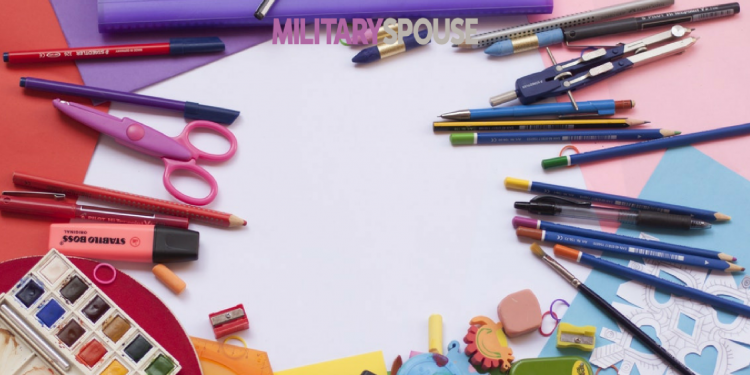I’ve checked off everything on my list for back to school.
- Registered for school. Check.
- School supplies. Check.
- New backpack. Check.
- Shiny new lunchbox. Check.
- New shoes. Check.
- Snack. Check.
- Band-Aids in backpack just in case said shoes give her blisters. Check.
- Bus schedule. Check.
I should feel pretty good about sending my third grader to her new school. But I don’t. I have a pit in my stomach. An ache in my head. A forced smile to cover up the worry. My hands are wringing with nervous energy. I speak in my “excited” voice hoping my words don’t crack as I’m getting her ready to go out the door.
I have another list in my head, an important list, that doesn’t have one single check yet.
- Someone to ride the bus with.
- A teacher who knows she struggles with loud noises.
- A teacher who knows this is her third school in four years.
- A teacher who knows she’s shy and won’t push her too much.
- A teacher who knows she’s really good in math.
- A teacher who knows she’s never been exposed to Common Core – this is her first year.
- A teacher who knows her father is deployed.
- A teacher who knows I’m nervous she needs an IEP.
- A teacher who knows we just moved here and we are still living without our belongings.
- A friend in the neighborhood.
- Someone familiar to sit with at lunch.
- Someone to play with at recess if she feels alone.
- A school that understands military connected kids.
- A teacher who knows she will act out if she’s not challenged in classroom.
For some reason, these items never seem to show up on a school’s registration form or school supply list.
As a parent, I’ve done everything I can think of to prepare my child for a new school. It’s been a rough move this summer and we are ready to be introduced to normal again. I’m going to hand my child over to a stranger with the hope she can magically read my child’s academic strengths and weaknesses at first glance. Or she’ll have the uncanny ability to know my child has attended four different schools by third grade without even asking.
But we know this isn’t how it works. It’s hit or miss finding the right teacher who will support us. Being a military family, we have to get ‘er done and turn worry into action.
Besides her parent, there is another adult who should be a willing participant and stakeholder in your child’s academic and emotional health – a teacher.
Build a Parent/Teacher Team
Building a parent/teacher team starts with communication. The best way to prepare your child for a new school is tell their educational history. Preparing the teacher for your child is as easy as using a three-ring binder and a hole-punch.
Many parents collect and travel with important documents when they PCS. However, I think students should travel with a continuity binder full of their educational history – it’s a lot more than just school transcripts!
This binder is beginning of the parent/teacher team. The parent rarely gets to see these sealed records before the exiting school gives them to you. It’s critical to show your future teammate — the teacher — your child’s academic strengths and weaknesses and not cherry picked printouts from on office. Sharing the binder with your child’s teacher(s) at their new school is the first step in building a team around your child.
What’s in the Education Binder?
1. Report cards from the past several years. Counselors want to see how a child has progressed and it allows them to understand more of the child’s academic past — not just one year; they want several years. Make notes on the report cards where drops in grades occurred due to deployments, homecomings, mid-year PCS’s or health problems.
2. Schoolwork samples. This is dependent on the grade level, but include math samples, handwriting, reading or essays. Be sure to include both exemplary work and evidence of weakness to give the new teacher a picture of the whole student. Depending on a child’s school, work could include art, writing, poetry or spelling.
3. Names of textbooks, photocopies of textbooks or sample workbooks used the previous year. This will help receiving teachers know what materials the student has been using the previous year.
4. Standardized Assessment results. It’s important to keep and maintain all standardized school testing results/reports a student or school has completed. States may offer different tests depending on resources and preference. Examples such Cog AT, Iowa Assessments, Terra Nova, Lexile, SRI, Reading Readiness, SAT, IQ tests or any results of standardized testing should be part of important documentation on a student.
5. Other evaluations. Speech therapy and occupational therapy reports, evaluations and assessments from school and outside school agencies should also be included to maintain continuity of service through moves.
6. Individual Education Plan and 504 Plan. Add a copy of the student’s IEP into the binder for backup purposes just in case the IEP is lost or not forwarded in time for registration.
7. Shot records. Shot records are needed to register for any new school. But consider keeping extra copies for camps, sports and child care providers.
8. Teacher-to-Teacher Communication. If you’re still in contact with your child’s previous teacher, ask them to write you a quick note introducing your child – the student – to their new teacher. The letter will give insight to personality, learning and skills that may take weeks or months for their new teacher to discover.
Teachers Should Know Their Students
Amanda Trimillios, a fellow military spouse, mother of four and a Nationally Board Certified Teacher, says the best teachers are the ones who really know their students.
“How can we teach a child unless we know who they are?” Amanda questions. “As teachers, it’s our job to know if this is their fifth school in six years, their father is deployed or they are still homeless looking for a house. It will help us understand where they are and if they are ready to learn.”
Amanda believes that military connected students are unique learners in the sense that they face different challenges than their civilian counterparts like frequent moves, changes in schools, and loss of credits and emotional connections.
“It’s critical the teachers view parents as their fellow team members when it comes to addressing the needs of the military connected students,” she says. “And it starts with communication and education history (the binder) even before the first day of school. We want to know who you are, what challenges you are currently facing as a military family. We care about your kids, too.”
My daughter is resilient – she’s earned it after attending four schools. She’s ready to tackle another school and meet as many friends as she can until it’s time to move again. She’s more ready than I will ever be. However, viewing the teacher as not just someone at school, but part of the team to support my military connected kid allows me to breathe a little easier.
I’m hoping to check a few more items off my “other” list after the teacher reads my students education binder. Until then, I’ll stop wringing my hands with worry. Instead, I’ll wrap my arms around my daughter and squeeze her until she begs me to let go. I’ll send her on her way knowing she has a team behind her.
[maxbutton id=”13″]




